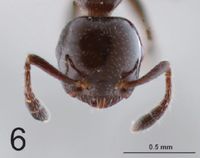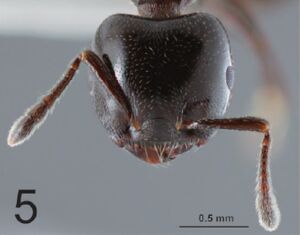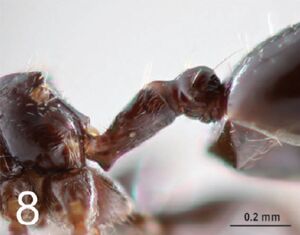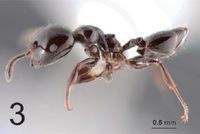Crematogaster indosinensis
| Crematogaster indosinensis | |
|---|---|

| |
| Scientific classification | |
| Kingdom: | Animalia |
| Phylum: | Arthropoda |
| Class: | Insecta |
| Order: | Hymenoptera |
| Family: | Formicidae |
| Subfamily: | Myrmicinae |
| Tribe: | Crematogastrini |
| Genus: | Crematogaster |
| Species: | C. indosinensis |
| Binomial name | |
| Crematogaster indosinensis Hosoishi & Ogata, 2016 | |
This species is known only from the type locality in Cambodia. The type material examined in this study was collected from permanent sample plots established by the Cambodian Forestry Administration. The author (SH) collected the workers foraging on lower vegetation. It is unknown whether C. indosinensis has a mutualistic relationship with ant-plants, because no information on their nesting habits is available. (Hosoishi and Ogata 2016)
Identification
Hosoishi and Ogata (2016) - Crematogaster indosinensis shares the following features diagnosed by Blaimer (2012c): 1) 10-segmented antennae; 2) rectangular head shape (but slightly wider than long in C. indosinensis); 3) suboval petiole in dorsal view; 4) globular postpetiole, and a faint posterior impression with the C. borneensis-group. Based on these morphological characters and molecular phylogenetic analysis, we consider C. indosinensis to be a member of the C. borneensis-group. Crematogaster indosinensis can be distinguished among the other members of the C. borneensis-group by the head being wider than long and having a developed subpetiolar process.
This species is similar to Crematogaster borneensis and Crematogaster decamera, but can be distinguished from both of these species by having a developed subpetiolar process (Fig. 8). While our collections of this species are very limited (n=4), but those specimens show distinct size polymorphism. The posterior portion of head is developed in large workers (Fig. 5), but rounded in small workers (Fig. 6). The head in the largest worker (HW 1.05) is ca. 1.7 X as wide as that one in the smallest worker (HW 0.62). In general, the C. borneensis-group associated with Macaranga does not show such polymorphism in size. The relationship between the presence/absence of polymorphism and ant-plant association is currently unclear because little is known about the biology of C. indosinensis.
Distribution
Distribution based on Regional Taxon Lists
Oriental Region: Cambodia (type locality).
Distribution based on AntMaps
Distribution based on AntWeb specimens
Check data from AntWeb
Countries Occupied
| Number of countries occupied by this species based on AntWiki Regional Taxon Lists. In general, fewer countries occupied indicates a narrower range, while more countries indicates a more widespread species. |

|
Estimated Abundance
| Relative abundance based on number of AntMaps records per species (this species within the purple bar). Fewer records (to the left) indicates a less abundant/encountered species while more records (to the right) indicates more abundant/encountered species. |

|
Biology
Castes
Worker
  
| |
| . | |
Nomenclature
The following information is derived from Barry Bolton's Online Catalogue of the Ants of the World.
- indosinensis. Crematogaster indosinensis Hosoishi & Ogata, 2016b: 808, figs. 3-8 (w.) CAMBODIA.
- Type-material: holotype worker, 3 paratype workers.
- Type-locality: holotype Cambodia: Kampong Thom Prov., 12°34’N, 105°23’E, 11.i.2010, SH10-Cam46, permanent sample plots (natural forest) (S. Hosoishi); paratypes with same data.
- Type-depositories: TNHM (holotype); BMNH, CASC, KUEC (paratypes).
- Distribution: Cambodia.
Unless otherwise noted the text for the remainder of this section is reported from the publication that includes the original description.
Description
Worker
HW = 0.78 (0.62–1.05); HL = 0.75 (0.60–1.00); CI = 104 (102–107); SL = 0.5 (0.42–0.63); SI = 65 (60–69); EL = 0.15 (0.12–0.18); PW = 0.44 (0.35–0.57); WL = 0.79 (0.65– 1.01); PSL = 0.05 (0.04–0.06); PtL = 0.21 (0.17–0.28); PtW = 0.18 (0.14–0.23); PtH = 0.14 (0.12–0.17); PpL = 0.13 (0.11–0.15); PpW = 0.17 (0.14–0.20); PtHI = 68 (61–71); PtWI = 87 (82–94); PpWI = 131 (127–137); WI = 94 (87–100) (n=4).
Workers with size polymorphism. Head subquadrate in full-face view, with weakly concave posterior margin, subparallel sides; posterior portion developed in large workers. Occipital carinae developed. Mandible with four teeth, apical and subapical teeth large. Anterior margin of clypeus convex; anterolateral margins of clypeus protruded anteriorly; posterior margin of clypeus rounded between frontal lobes. Frontal carinae almost parallel. Antennae 10-segmented; antennal club 2-segmented. Scape not reaching posterior corner of head. Basal flagellar segment (antennal segment III) slightly broader than long. Compound eyes not projecting beyond lateral margins of head in full face view.
Pronotum and mesonotum almost fused without defined suture, forming same dorsal outline in lateral view. Metapleural gland opening slit-shaped. Propodeal spiracle circular, situated at posterolateral corners, not touching metapleural gland bulla. Metanotal groove convex posteriorly in dorsal view, deep and forming concave region between mesonotum and propodeum. In dorsal view, longitudinal rugulae connecting between mesonotum and propodeum; the boundary distinct. Propodeal spines weakly developed as short process.
Petiole elliptical shaped, but flattened with weakly convex sides, slightly longer than broad; spiracle situated at almost midportion between dorsal and ventral margin of petiole in lateral view, directed laterally. Subpetiolar process developed. Postpetiole without longitudinal median sulcus, but weakly bilobed behind in large workers; spiracle situated anteriorly on lateral surface.
Dorsal surface of head generally smooth; gena with rugulae. Clypeus with longitudinal rugulae in large workers, but weakly punctate in small workers. Promesonotum smooth and shining, but anterior collar sculptured. Lateral surface of pronotum smooth and shining. Mesopleuron generaly smooth, but with longitudinal rugulae on higher portion. Anterodorsal surface of propodeum smooth and shining, but posterior declivity punctate. Lateral surface of propodeum generally smooth and shining. Dorsal and lateral surfaces of petiole smooth and shining. Dorsal and lateral surfaces of postpetiole smooth and shining.
Standing pilosity sparse. Dorsal face of head with some pairs (ca. 6–7) of erect setae and short appressed setae. Clypeus with some pairs (ca. 3–4) of erect setae. Anterior clypeal margin with single median setae and one pair of long setae mixed with short setae laterally. Scape with erect and appressed setae sparse. Promesonotal dorsum with sparse erect setae and appressed setae. Petiole with one pair of suberect setae posteriorly. Postpetiole with three pairs of suberect setae dorsally, laterally, and posteriorly. Fourth abdominal tergite with appressed setae and sparse erect setae. Body color red-brown.
Type Material
HOLOTYPE. Worker, labeled: “Cambodia: Permanent Sample Plots (natural forest), Kampong Thom Province, 12°34’N, 105°23’E, 11.i.2010 (SH10-Cam46) (S. Hosoishi)” (Natural History Museum of the National Science Museum: KUMANT034). PARATYPES. Three workers, same data as holotype. Deposited in The Natural History Museum: KUMANT035, California Academy of Sciences: KUMANT036, Entomological Laboratory and Institute of Tropical Agriculture, Faculty of Agriculture, Kyushu University: KUMANT037).
Etymology
The specific name refers to the region from which the material is collected.

